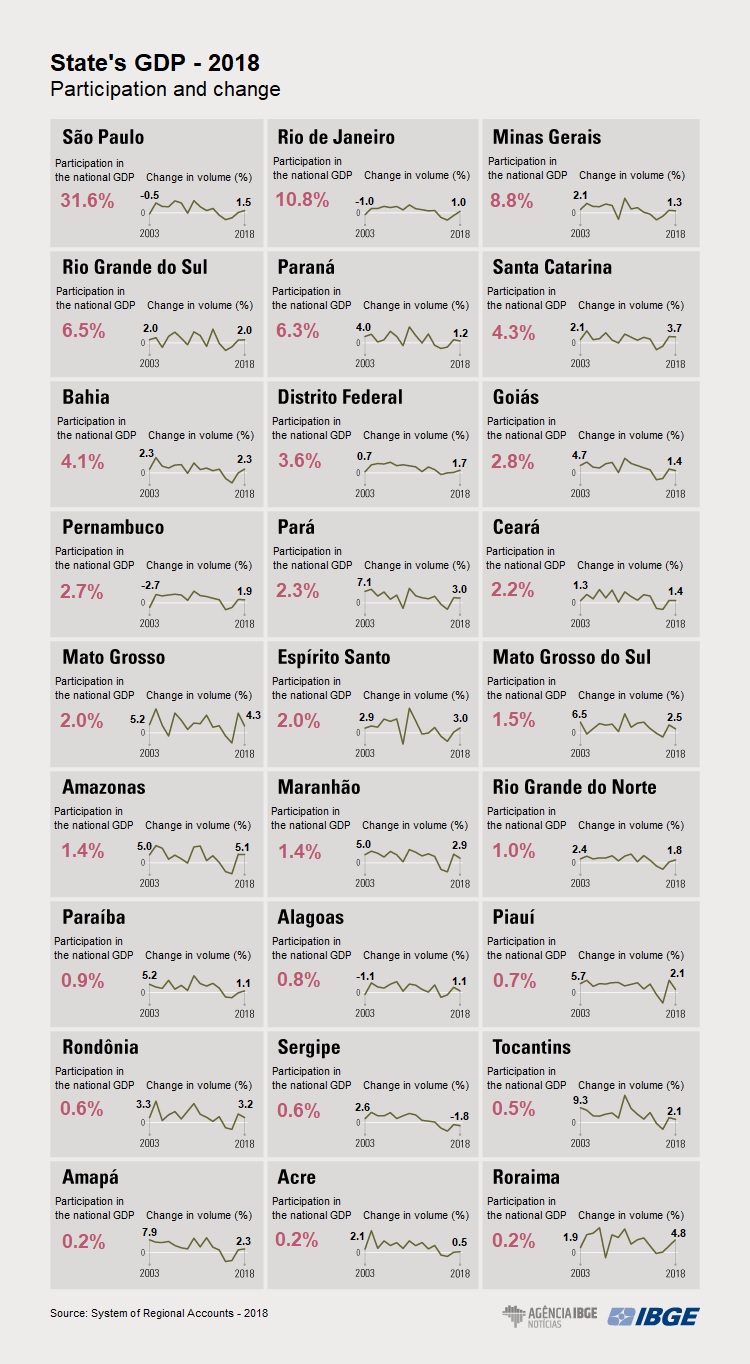Regional Accounts
Fifteen states have GDP above the national average in 2018; only Sergipe records a drop
November 13, 2020 10h00 AM | Last Updated: November 17, 2020 12h27 PM

Fifteen states registered growth of volume in the Gross Domestic Product – GDP 2018 above the national average, which was 1.8%. Amazonas registered the highest growth: 5.1%. On the other hand, Sergipe was the only Federation Unit to lose GDP volume, with a drop of 1.8%, the fourth consecutive year with a negative result. The other 11 states rose, but below the national rate.
The data are from the Regional Accounts 2018, released today (13) by the IBGE, and produced in partnership with State Statistical Offices, State Government Secretariats and the Superintendence of the Manaus Free Trade Zone - SUFRAMA.
According to the IBGE technician Luiz Antonio de Sá, the negative result in Sergipe is related not only to economic performance, but also due to adverse weather conditions in 2018.
“The lack of rainfall caused an abrupt fall in the agricultural output in the state and the agriculture lost 34.7% in volume,” he highlights. Another sector that had a performance below the national average and contributed to the drop was service activities, the activity group that grew the most in the national economy and was very influential, especially in states with less developed industries, which is the case of the Northeastern state. The Sergipe rate was below the national average (2.1%), growing 0.2%. The industry, although not being so influential in the state, also did not contribute, dropping 2.6%.
With the best figure among the states with the highest volume growth, Amazonas (5.1%) exemplifies the good result of the country’s North. The region grew the most in terms of GDP volume, 3.4%. Roraima (4.8%) and Rondônia (3.2%) are the northern states that are also among the top five in the ranking.
Sá explains that the growth in each of these states was due to different factors. Amazonas has a profile considered atypical in the region, due to the strong influence of the Manufacturing industries activity, which grew 8.8% from 2017 to 2018, motivated by the segment of computer equipment. “Due to the Manaus Free Trade Zone, the state has a key role not only regional, but also national,” says the IBGE technician.
In Roraima, the profile is more focused in services activities, which grew 4.4%, boosted especially by trade and public administration. “There was an important population increase, an inflow of immigrants, and that influenced consumption,” reminds Sá. Rondônia also grew in industry activities (4.8%), driven by the generation of electricity. Mato Grosso (4.3%) and Santa Catarina (3.7%) complete the top five list.
The survey also shows that some states lost share in the national GDP. São Paulo, which lost 0.6 p.p. of the country’s total and, for the second consecutive year, had the biggest loss in relative figure. “Generally, larger states have a higher capacity for share variations. São Paulo had a share drop equivalent to Rondônia´s GDP, for example,” highlights Sá. Among the activities that contributed to this share loss in São Paulo, Financial activities, insurance and related services, which has the São Paulo state representing more than 50% of the national total, stood out.
“This activity lost share in 2017 and 2018, mainly due to the decrease in interest rates,” explains the expert.

Southeast is the only region to grow below the national average
Regarding the regions, the Southeast (1.4%) was the only one with a volume change lower than the national index. The only state that grew above the national average in the most populated region of the country was Espírito Santo (3%). At the list top is the North (3.4%), followed by Central-West (2.2%) and South (2.1%). The Northeast grew the same as the national average (1.8%).
Despite growing below the average, the Southeast increased its share in the Brazilian economy in 2018, going from 52.9% to 53.1% in relation to the national GDP. The survey shows that such increase is due to Rio de Janeiro and Espírito Santo performance, which added more 0.6 and 0.3 p.p., respectively, and were the two states with the higher increase in relative figures. The South also increased its share, by 0.1 p.p., due to the contribution of Santa Catarina. In contrast, the North, Northeast and Central-West regions lost share (-0.1 p.p. each).
In the analysis of the GDP under the point of view of income, the compensation of the employed persons, the major component of the index, lost share in relation to the year before 2017, going from 44.3% to 43.6% of the Brazilian GDP in 2018. It is the second negative result in a row.
“The performance is linked to the drop in the number of employed persons with a formal contract,” explains Sá. The regions that influenced the most in this loss of participation were the South, whose compensation of the employed persons participation was 42.7% in 2017 and went to 42% in 2018, and especially the Southeast (from 43.9% to 42.8%), where Rio de Janeiro and Espírito Santo were the states that increased the index, due to the Mining and quarrying industries.
The per capita GDP in the country in 2018 was R$33,593.82, which represents an increase of 5.9% in value in relation to 2017 (R$31,712.65). The Federal District remained in the lead, with R$85,661.39, nearly 2.5 times higher than the national average. In the ranking of the per capita GDP, the states of the Southeast, South and Central-West prevailed among the first 10 positions.



















